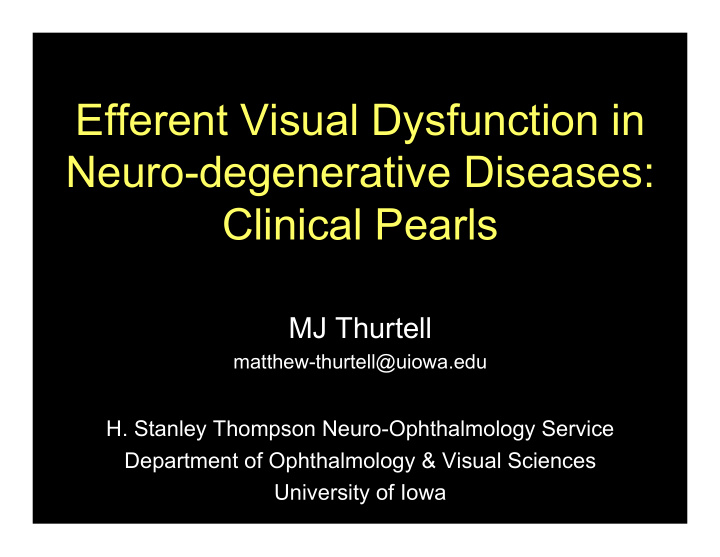



Efferent Visual Dysfunction in Neuro-degenerative Diseases: Clinical Pearls MJ Thurtell matthew-thurtell@uiowa.edu H. Stanley Thompson Neuro-Ophthalmology Service Department of Ophthalmology & Visual Sciences University of Iowa
Disclosures • Financial disclosure: I do not have any relevant financial interests or relationships to disclose • Off-label use of product disclosure: I will be discussing off-label use of drugs for nystagmus
Objectives • To review symptoms and signs of efferent dysfunction in neurodegenerative disease • To review the neuro-ophthalmic deficits associated with cerebellar degenerations and progressive supranuclear palsy • To discuss management strategies to address the neuro-ophthalmic deficits in cerebellar degenerations and progressive supranuclear palsy
Symptoms of efferent visual dysfunction • Often vague and/or non-specific • May suggest efferent dysfunction: – Diplopia – Oscillopsia – Difficulty with depth perception • May suggest afferent dysfunction: – Blurred vision – Difficulty reading • May be asymptomatic
Signs of efferent visual dysfunction in neurodegenerative disease POSTERIOR CORTEX: ANTERIOR CORTEX: impaired visually-guided impaired voluntary eye movements (e.g., eye movements (e.g., oculomotor apraxia) anti-saccade test errors) MIDBRAIN: vertical saccadic BASAL GANGLIA: palsy, convergence fixation instability, insufficiency increased saccadic latency, saccadic hypometria CEREBELLUM: PONS: nystagmus, impaired smooth horizontal saccadic palsy pursuit, saccadic dysmetria
Clinical pearl: ocular motor apraxia Q. How can you differentiate a supranuclear motility deficit from a nuclear-infranuclear motility deficit? A. The deficit from a supranuclear lesion can be overcome with the doll’s eyes maneuver (vestibulo-ocular reflex) whereas the deficit from a nuclear-infranuclear lesion cannot
Orbital apex Superior orbital fissure Cranial nerve Cavernous sinus Subarachnoid space Supranuclear and internuclear pathways Extraocular Eye muscle Neuromuscular junction Cranial nerve nucleus and fascicle Inner ear
Clinical pearl: ocular motor apraxia Chen JJ & Thurtell MJ. J Neurol Neurosurg Psychiatry 2012; 83: 1117-1118
Clinical pearl: saccadic slowing Q. How can you differentiate slow saccades due to a nuclear-infranuclear (e.g., sixth nerve nucleus) lesion from those due to a supranuclear (e.g., PPRF) lesion? A. The slow saccades due to a nuclear- infranuclear lesion are associated with limited ductions, whereas those due to a supranuclear lesion are often not
Slow saccades from bilateral PPRF lesions Courtesy of RJ Leigh & DS Zee
Neuro-ophthalmic features of cerebellar degenerations • Fixation abnormalities: – Downbeat nystagmus – Gaze-evoked and rebound nystagmus – Periodic alternating nystagmus – Macrosaccadic oscillations • Other motility abnormalities: – Comitant esotropia – Alternating skew deviation – Saccadic dysmetria – Impaired smooth pursuit – Impaired VOR suppression
Clinical pearl: downbeat nystagmus
Clinical pearl: gaze-evoked and rebound nystagmus Rebound nystagmus Gaze-evoked nystagmus
Clinical pearl: saccadic dysmetria • Saccadic hypermetria: – Lesion: cerebellar fastigial nuclei – Saccades are too big, may have associated macrosaccadic oscillations – Pearl: elicit using close visual targets • Saccadic hypometria: – Lesion: dorsal cerebellar vermis – Saccades are too small, may be “staircase” – Pearl: elicit using more distant visual targets
Clinical pearl: managing motility deficits of cerebellar degenerations • Prism for primary position misalignment • Single-vision distance and reading glasses • Medications for downbeat nystagmus: – 4-aminopyridine (5 mg qid) – Clonazepam (0.5-1 mg bid) • Medications for periodic alternating nystagmus: – Baclofen (5-10 mg tid) – Memantine (5-10 mg qid) • Medications for macrosaccadic oscillations: – Memantine (5-10 mg qid)
Neuro-ophthalmic features of progressive supranuclear palsy • Eyelid abnormalities: – Lid retraction Dry eye, blepharitis – Decreased blink rate – Blepharospasm • Fixation abnormalities: – Square-wave jerks
Clinical pearl: square-wave jerks Courtesy of RJ Leigh & DS Zee
Neuro-ophthalmic features of progressive supranuclear palsy • Eyelid abnormalities: – Lid retraction Dry eye, blepharitis – Decreased blink rate – Blepharospasm • Fixation abnormalities: – Square-wave jerks • Other motility abnormalities: – Convergence insufficiency – Vertical>>horizontal saccadic palsy • Saccades are slow • Saccades are hypometric
Normal PSP Chen et al. Front Neurol 2010; 1:147 [doi: 10.3389/fneur.2010.00147]
Clinical pearl: demonstrating directional saccadic palsy Courtesy of RJ Leigh & DS Zee
Clinical pearl: oscillations in CNS Whipple’s disease Oculomasticatory myorhythmia Courtesy of S Wray
Clinical pearl: managing neuro-ophthalmic deficits of PSP • Eyelid hygiene: – Lid scrubs and warm compresses • Eye lubrication: – Artificial tears QID – Lubricating ointment QHS • Single-vision distance and reading glasses • Prism in reading glasses for convergence insufficiency; consider monocular occlusion • Prism to assist with downward saccadic palsy
“Bed specs” ($10) www.amazon.com
Recommend
More recommend